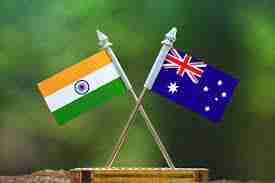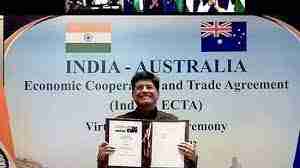India-Australia Bi lateral Trade: Forging solid bonds with Game Changer Trade Agreement-ECTA 2022

The recently inked India-Australia ECTA pact will take bilateral trade to new heights for both countries.
That India is among the fastest-growing economies in the world is now an acknowledged fact, and its impact on the global economic field is beginning to take shape. India’s fundamentals are strong; politically, it is a stable nation, its middle-class market is among the world’s largest, and global R&D and manufacturing corporations are showing keen interest in using India’s cost-effective talent and exceptional infrastructure offered. Objectively speaking, all these things have happened over time, and India’s open-minded attitude and level-headed thinking policymakers have gotten the attention of progressive nations worldwide.
Australia and India established diplomatic ties in the pre-Independence period when the Consulate-General of India was first opened as a Trade Office in Sydney in 1941. Australia’s relationship with India predates the latter’s Independence and is among the oldest continuous formal diplomatic relations with any Asian country. Australia is the first country India has established full diplomatic relations with.
The Australian Government’s diplomatic network in India includes High Commission in New Delhi and Consulates-General in Chennai, Mumbai, and Kolkata. And plans are underway to open a Consulate-General soon in Bengaluru, India’s tech capital.
Meanwhile, the Australia-India relationship was upgraded to a Comprehensive Strategic Partnership (CSP) on 4 June 2020. This is evidence of how things are looking ahead between the two countries.
According to the Global Trade Research Initiative, bilateral trade between India and Australia will be around US$70 billion by 2028. India-Australia ECTA (Economic Cooperation and Trade Agreement), which comes into force effective 29 December 2022, will benefit Indian trade and investment prospects beyond words. “The India-Australia ECTA is expected to boost investments, enhance market access, create additional job opportunities, and most importantly strengthen the bilateral ties of two important players in the Indo-Pacific region.”, says Sanjay Budhia (Chairman, Confederation of Indian Industry (CII) National Committee on EXIM). (Source India Briefing).
India-Australia Bilateral Trade
Besides people-to-people ties, mutual admiration for cricket and hockey, and a preferred destination for higher studies by Indian students, the India-Australia partnership is backed up by many commonalities. Both nations have Westminster-style democracies, Commonwealth culture, growing economic engagement, and increasing high-level interaction (governmental and commercial delegations) is reflected in our ongoing bilateral trade relationship.
Australia and India upgraded their bilateral relationship to Comprehensive Strategic Partnership (CSP) in 2020 with established institutional mechanisms to promote bilateral cooperation, including trade, business, and investment.
Currently, India is Australia’s 8th largest trade partner, with trade valued at A$ 26.24 billion, representing a 3% share of the total Australian work in 2019-20. Over the last three decades, India-Australia Joint Ministerial Commission has been operational to explore new avenues in trade and business. To further facilitate future business and commerce, the Australian Government has commissioned the India Economic Strategy to 2035, an ambitious roadmap for Australia to unlock opportunities offered by Indian Economic growth. (Source Australian Govt Report)
India-Australia Bilateral Trade – The Current Scenario
India is Australia’s 8th largest trade partner, and the annual trade is valued at A$ 26.24 billion. India exports refined petroleum, Pharmaceuticals (incl. veterinary), Pearls & gems, Jewellery, Made-up textile articles, textile clothing, and other base metal material.
India imports Coal, Confidential trade items, Copper ores & concentrates, Natural gas, Non-ferrous waste & scrap, ferrous waste & scrap, and education-related services. Education is Australia’s largest service export to India, valued at $6 billion in 2020.
Key business Facilitators – Bringing momentum in our bilateral trade.
India-Australia CEO Forum
Established in 2011, it acts as an organized forum facilitating the business, adding velocity to our bilateral trade and investment relationship.
Treasury-NITI Ayog Economic Policy Dialogue
Led by the CEO of Indian NITI Aayog, a delegation visited Australia in 2019 and held a dialogue with the Australian counterpart.
AIBX – Australia India Business Exchange program ( AIBX),
It is an Australian government initiative that helps Australian business enterprises with ongoing research, guidance, and investment plans in India.
Dynamics behind the growing India- Australian trade and Business Partnership
In the current geopolitical scenario, when the world economy is undergoing economic stress due to the adverse effect of the pandemic and the never-ending Ukraine war, boosting trade and business ties between like-minded nations remains the only solution. The current geopolitical scenario globally and China’s containment in the Indo- pacific region that translated into a closer trade tie between India and Australia in recent years.
On its part, India is also trying to establish its new global image and credentials as a country ready to do business by providing opportunities for foreign investors and creating a business environment with investor-friendly policies. India has a business and trade focussed international relation policy .and negotiates various trade deals and agreements with progressive like-minded partners.
Despite significant differences over the Ukraine crisis, both countries remain committed to an upward trajectory in their strategic partnership. Both nations play a catalytic role in keeping the multipolar character of the Indo pacific region by initiating a close bonding and trade partnership.

India-Australia Economic Cooperation and Trade Agreement (IA -ECTA) April 2022

Union Minister of Commerce and Industry Piyush Goyal shows the virtually signed agreement of the India-Australia Economic Cooperation and Trade Agreement (IndAus ECTA) witnessed by Prime Minister Narendra Modi and Australian Prime Minister Scott Morrison in New Delhi.
The India-Australia free trade agreement (ECTA) pact is the first trade pact signed by India with a developed economy after a long time. ECTA will likely extend a much-needed push on bilateral trade with lower tariffs on many goods. It also addresses non-tariff barriers, such as technical trade barriers and sanitary and phytosanitary restrictions.
India-Australia ECTA 2022 is an excellent start for India’s international trade prospect. Besides making our bilateral trade shooting to almost $50 billion in the next five years, it will send a positive signal to other developed economies like the EU, Canada, and UK, where active negotiations are on for similar deals.
As the fifth-largest economy in the world today. India must not lose out on preferential market share, strengthen its export competitiveness, and work on trade pacts with other developed economies.
ECTA 2022 agreement was finally reached after ten years of ongoing negotiation; Indian prime minister Mr. Narendra Modi described the treaty as “a watershed moment for our (India-Australia) bilateral relations” during the virtual signing ceremony with the Australian counterpart prime minister Mr. Scott Morrison.

ECTA 22 will boost India Australia’s trade Ties
Effective 29 December 2022. the India-Australia Economic Cooperation and Trade Agreement (ECTA) come into force. Aiming to improve trade and investment opportunities between the two nations, our bilateral trade volume is expected to reach 50 billion US $ over the next five years.
Direct Business Impact of the Agreement
Going by the agreement, Australia would grant India preferred market access on all of its tariff lines, including the significant Indian labor-intensive sectors with high export volume potential for India, such as gems and jewelry, textiles, leather, footwear, furniture, food, agricultural products, engineering products, medical technology, and autos.
Reciprocally, India will extend Australian businesses preferential access to over 70 percent of its tariff lines, such as raw materials and intermediaries like coal, mineral ores, and wines, which have high export potential from Australian export prospects.
Automotive electrification is picking up significantly in India, and though there’s a high level of localization, certain minerals like lithium have to be imported to make battery cells for EVS. Australia is rich in this resource, and India has recently located lithium in J&K.
The IA-ECTA eliminates tariffs on over 85% of Australian goods exported to India. It is expected to rise further as the Department of foreign affairs and trade, Govt of Australia estimates this will be “commercially significant for up to $14.8 billion worth of Australian merchandise trade destined for the Indian market each year. It will also allow approx. 96% of Indian imports enter Australia duty-free.
Moreover, in every like hood, around 10 lakh employment opportunities will be created in India in the next 4-5 years. More than a lakh Indian students will benefit from the Post-Study Work Visa and work in Australia.
The India-Australia ECTA can play a significant role in realizing the cherished dream of a self-reliant India. The agreement is expected to boost bilateral trade from $27 billion to $45-50 billion. Australia will offer zero duty on approximately 96.4% of exports from Day One. This list includes items that usually attract 4-5% customs duty in Australia.
Global Trade Research Initiative, a leading global think tank, expects the India-Australia bilateral trade (in merchandise and services) to touch $70 billion in the coming five years due to the buoyant trade pact and Australia’s gradual growth distancing from China.
From India’s perspective, IA ECTA is a new milestone trade agreement with a developed economy. With IA-ECTA in force, India aims to engage in free trade agreements with other key developed economies in the future, including the EU, UK, Canada, GCC, and Israel.
For Reading More Posts on Global Geo-politics, click here
The Article has Great Analysis and is full of facts and statistics.
A good write-up!
Thanks a lot, Rehan for your encouraging words
Regards
Utpal
Detailed article and definately the trade pact will be positive for both the indo Australian side
Thanks, Bindusaar for the encouraging words
Regards
Utpal